
a web page by Don Roberson |
WHISTLERS & ALLIES Pachycephalidae Whistlers, shrike-thrushes, and allies |
|
Some whistlers have become rare with loss of habitat. Red-lored Whistler (below) is resident in open canopy mallee eucalyptus over a dense shrub layer, usually with spinifex, centered at the junction of three states in southeastern Australia. Clearance of mallee in the 19th and 20th centuries reduced the historic range by over half. The best habitat is mallee unburned for for over 20 years. Fire is now the current threat. |
 |
|
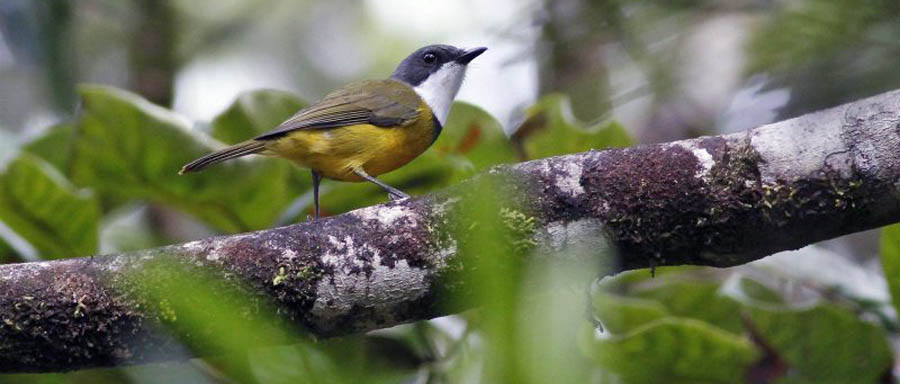 |
The most widespread colonist was the "golden whistler" group. Nearly all were lumped together as "Golden Whistler P. pectoralis," with only the mangrove specialist Black-tailed Whistler P. melanura separated as a different species [often called "Mangrove Golden Whistler" in Australia]. There was tremendous diversity among these birds (Galbraith 1956). In 2012, following the DNA studies by Jønsson (2008b), Clements (and other global lists), split the existing two "golden whistlers" into ten species. One of those species was New Caledonian Whistler (above in a nice shot by Murray Loard). The full set was:
and in 2014 the 11th species became
This was because Andersen et al. (2014) did a further molecular study that essentially confirmed the 10-way split above, but also found that the nominate subspecies of New Caledonian Whistler P. c. caledonica is the sister species to Hooded Whistler P. implicata, whereas subspecies P. caledonica intacta is related to a different group of species of whistlers. In adopting this 11th split in the group, the Clements' checklist authors noted that "we would not be surprised if future research shows that either or both of these species will need to be split (again)." There is an isolated population of "golden whistler" in the Balim Valley on eastern New Guinea; it was recently split as Balim Whistler P. balim by Pratt & Beehler's (2015) new field guide to New Guinea. To date there has been no molecular studies of this taxon but surely it is a different species than the widespread Golden Whistler of Australia. |
Some shrike-thrushes arefound in thick jungle but others, such as Sandstone Shrike-Thrush C. woodwardi, are confined to arid sandstone cliffs in north-central Australia. Only three Pitohuis are part of the this family — Rusty Pitohui C. ferrugineus, White-bellied Pitohui C. incerta, and Black Pitohui Melanorectes nigrescens — the remainder go to other families; Norman et al. (2009). The pitohuis are birds of thick tropical jungles in New Guinea; the first two in steamy lowlands, the Black in montane cloud forests. One of the most impressive attributes of some pitohuis, and a few whistlers, is the presence of a poisonous toxin in their skin and feathers. A powerful neurotoxin, chemically similar to that found in Central American poison dart frogs, is present and has long been known to native peoples in New Guinea, who avoid eating pitohuis. Dumbacher et al. (2008) found that the presence of neurotoxic alkaloids has evolved several times in New Guinea birds (Jønsson et al. 2008a). It appears most potent in the true Pitohuis — Variable Pitohui P. kirhocephalus and Hooded Pitohui P. dichrous, which now have proven to be closely related to Old World oriole [Oriolidae]. They have evolved conspicuously orange-and-black plumage as a warning, similar to patterns of colorful "warning" evolved in Monarch butterflies. There are now questions as to whether other birds have evolved Müllerian mimicry in response (Dumbacher & Fleischer 2001). The toxins come from eating poisonous melyrid beetles (Choresine), and the toxins are stored in the skin and feathers. They have been detected in Black "Pitohui" and in Rusty "Pitohui," which are not true pitohuis but are whistlers; in Rufous Shrike-Thrush Colluricincla megarhyncha of New Guinea; and in Blue-capped Ifriti Ifrita kowaldi, a New Guinea endemic that is now within its own family (Dumbacher et al. 2008, Norman et al. 2009). |
The outlines of the Whistler family has been changing for some year. Both Shrike-tit Falcunculus frontatus and Wattled Ploughbill Eulacestoma nigropectus were once considered Whistlers, but early studies suggested they were related to each other, and even separated out these two genera as their own family Falcunculidae (Dickinson 2003). A newer study did not support this hypothesis (Norman et al. 2009), and Shrike-tit got placed back with Whistlers. More recently, Jønsson et al. (2016) proposed elevating both the Shrike-tit and the Ploughbill to separate single-species families; I have now adopted that proposal. Among other new relationships uncovered by molecular evidence was that Crested Bellbird Oreoica gutturalis of Australia, Crested Pitohui Ornorectescristatus of New Guinea, and Rufous-naped Whistler Aleadryas rufinucha, also of New Guinea, were closely related and are not within the Pachycephalidae (Norman et al. 2009). They are now assigned to a new family, the Australo-Papuan Bellbirds [Oreoicaedae]. The unique New Zealand genus Mohoua — with species Whitehead, Yellowhead, and Pipipi — were often placed among the Whistlers. Norman et al. (2009) found Mohoua to "have no obvious links to any pachycephaline genera" but beyond that the relationships were muddy. More recently, Jønsson et al. (2016) found evidence that the Mohouids are an ancient basal lineage that are sister to all the rest of the corvoids. They are now also in their own family [Mohouidae]. We now know that Mottled "Whistler" Rhagologus leucostigma of New Guinea is not a whistler but is within a clade that includes woodswallows and African bush-shrikes (Norman et al. 2009). It, too, has recently been elevated to its own single-species family by Jønsson et al. (2016), the Berryhuner [Rhagoloidae]. Most dramatically, Olive-flanked "Whistler" Hylocitrea bonensis of montane Sulawesi proved not to be a whistler, but instead is a member of the bombycillid radiation — it is related to waxwings, Palmchat and Hypocolius (Spellman 2008) — and is current best placed in its own family [Hylocitreidae].
|
Photos: The Golden Whistler Pachycephala pectoralis was in Dryandra Forest, Western Australia, on 4 Aug 2008. The Gilbert's Whistler P. inornata was on Gulpa Island, New South Wales, Australia, on 31 Dec 1997. Murray Lord photographed the New Caledonian Whislter P. caledonica in the Parc du Riviére Bleue, New Caledonia on 22 March 2010. The Gray Shrike-Thrush Colluricincla harmonica was at the Stirling Range Resort, Western Australia, on 11 Aug 2008. Uncredited photos © Don Roberson; Credited photos © Murray Lord, as credited, and used with permission; all rights reserved. Bibliographic note: There is no "family book" covering the Pachycephalidae but there is an excellent introduction in the Handbook of the Birds of the World series (Boles 2007), even if it included more species than are now attributed to this family. Literature cited:
|
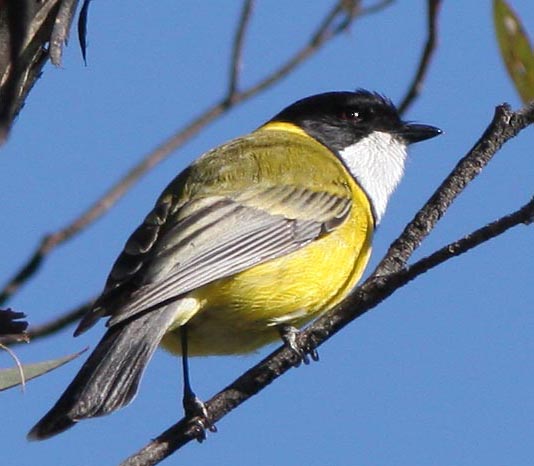 The
Pachycephalidae is a diverse family of landbirds within Australasia.
The parameters of this family has been unstable in recent years but
after a series of molecular studies, it has been whittled down to its
core (e.g., Barker et al 2004, Norman et al. 2009, Jønsson 2008,
2011, 2015). The center of that core is the genus Pachycephalus — 44 species of whistlers (including Morningbird P. tenebrosa of Palau). Pachycephalus whistlers are primarily forest birds in the mid or upper canopy, ranging from dull species to some bright ones, such as Golden Whistler
(left), widespread across Australia. It was once considered extremely
variable, with assorted subspecies from Wallacea to Oceania, but was
recently split into numerous species (more on that below).
The
Pachycephalidae is a diverse family of landbirds within Australasia.
The parameters of this family has been unstable in recent years but
after a series of molecular studies, it has been whittled down to its
core (e.g., Barker et al 2004, Norman et al. 2009, Jønsson 2008,
2011, 2015). The center of that core is the genus Pachycephalus — 44 species of whistlers (including Morningbird P. tenebrosa of Palau). Pachycephalus whistlers are primarily forest birds in the mid or upper canopy, ranging from dull species to some bright ones, such as Golden Whistler
(left), widespread across Australia. It was once considered extremely
variable, with assorted subspecies from Wallacea to Oceania, but was
recently split into numerous species (more on that below).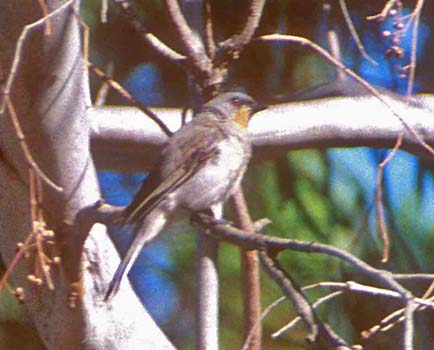 Gilbert Whistler (right) is a specialty of dry gum eucalypt woodlands of southern Australia. Vogelkop Whistler P. meyeri exists only in high montane forests in the Vogelkop Mts. in western New Guinea. Drab Whistler (below) is endemic to open lowlands forests in Wallacea.
Gilbert Whistler (right) is a specialty of dry gum eucalypt woodlands of southern Australia. Vogelkop Whistler P. meyeri exists only in high montane forests in the Vogelkop Mts. in western New Guinea. Drab Whistler (below) is endemic to open lowlands forests in Wallacea. 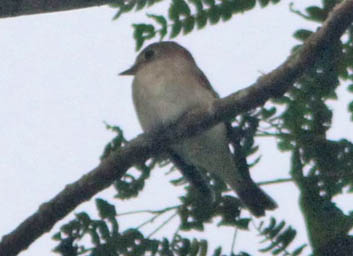
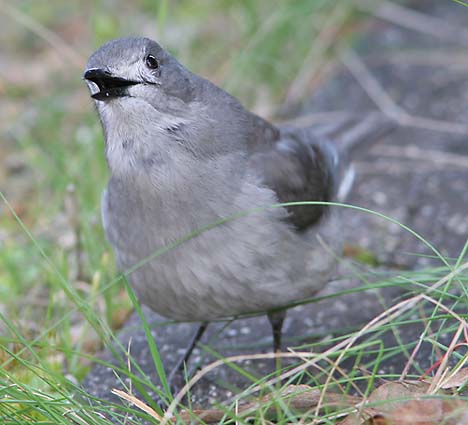 Many whistlers are much more easily heard than seen, and this can be especially true of the 7 species of Colluricincla shrike-thrushes and pitohuis of Australia and New Guinea. The impressive vocalization of Grey Shrike-Thrush
(right) are a common sound in Australian woodlands, but getting views
(or photos!) can often be a challenge. This photo actually catches one
in mid-song.
Many whistlers are much more easily heard than seen, and this can be especially true of the 7 species of Colluricincla shrike-thrushes and pitohuis of Australia and New Guinea. The impressive vocalization of Grey Shrike-Thrush
(right) are a common sound in Australian woodlands, but getting views
(or photos!) can often be a challenge. This photo actually catches one
in mid-song.